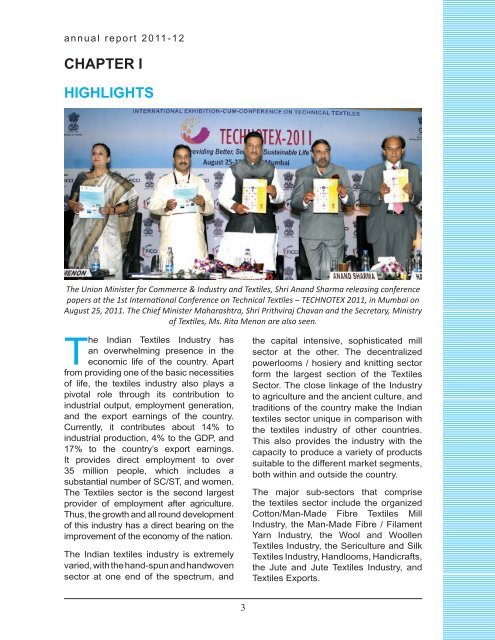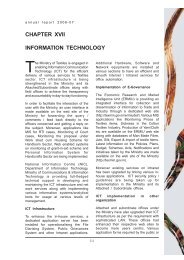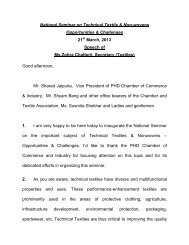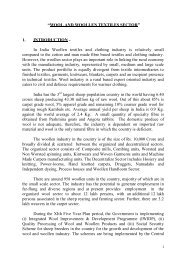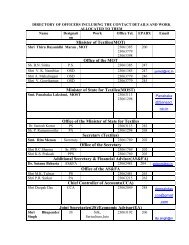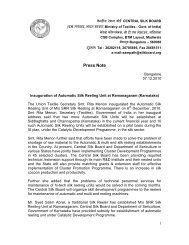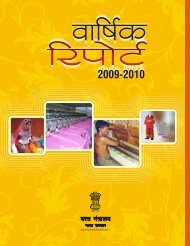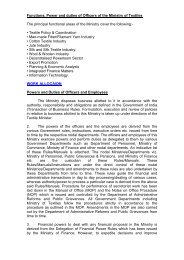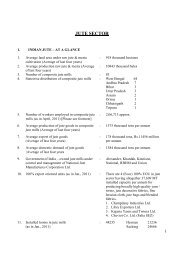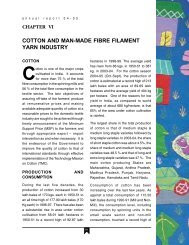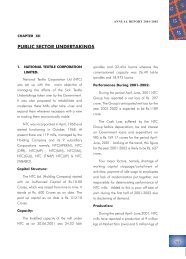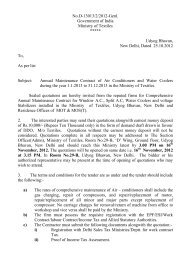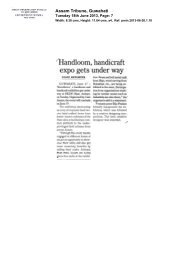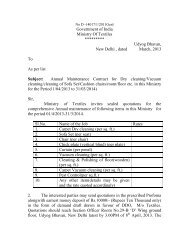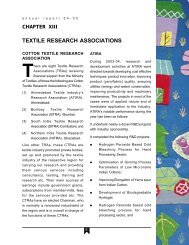chapter viii wool & wollen textiles industry - Ministry of Textiles
chapter viii wool & wollen textiles industry - Ministry of Textiles
chapter viii wool & wollen textiles industry - Ministry of Textiles
You also want an ePaper? Increase the reach of your titles
YUMPU automatically turns print PDFs into web optimized ePapers that Google loves.
annual report 2011-12<br />
CHAPTER I<br />
HIGHLIGHTS<br />
The Union Minister for Commerce & Industry and <strong>Textiles</strong>, Shri Anand Sharma releasing conference<br />
papers at the 1st International Conference on Technical <strong>Textiles</strong> – TECHNOTEX 2011, in Mumbai on<br />
August 25, 2011. The Chief Minister Maharashtra, Shri Prithviraj Chavan and the Secretary, <strong>Ministry</strong><br />
<strong>of</strong> <strong>Textiles</strong>, Ms. Rita Menon are also seen.<br />
The Indian <strong>Textiles</strong> Industry has<br />
an overwhelming presence in the<br />
economic life <strong>of</strong> the country. Apart<br />
from providing one <strong>of</strong> the basic necessities<br />
<strong>of</strong> life, the <strong>textiles</strong> <strong>industry</strong> also plays a<br />
pivotal role through its contribution to<br />
industrial output, employment generation,<br />
and the export earnings <strong>of</strong> the country.<br />
Currently, it contributes about 14% to<br />
industrial production, 4% to the GDP, and<br />
17% to the country’s export earnings.<br />
It provides direct employment to over<br />
35 million people, which includes a<br />
substantial number <strong>of</strong> SC/ST, and women.<br />
The <strong>Textiles</strong> sector is the second largest<br />
provider <strong>of</strong> employment after agriculture.<br />
Thus, the growth and all round development<br />
<strong>of</strong> this <strong>industry</strong> has a direct bearing on the<br />
improvement <strong>of</strong> the economy <strong>of</strong> the nation.<br />
The Indian <strong>textiles</strong> <strong>industry</strong> is extremely<br />
varied, with the hand-spun and handwoven<br />
sector at one end <strong>of</strong> the spectrum, and<br />
the capital intensive, sophisticated mill<br />
sector at the other. The decentralized<br />
powerlooms / hosiery and knitting sector<br />
form the largest section <strong>of</strong> the <strong>Textiles</strong><br />
Sector. The close linkage <strong>of</strong> the Industry<br />
to agriculture and the ancient culture, and<br />
traditions <strong>of</strong> the country make the Indian<br />
<strong>textiles</strong> sector unique in comparison with<br />
the <strong>textiles</strong> <strong>industry</strong> <strong>of</strong> other countries.<br />
This also provides the <strong>industry</strong> with the<br />
capacity to produce a variety <strong>of</strong> products<br />
suitable to the different market segments,<br />
both within and outside the country.<br />
The major sub-sectors that comprise<br />
the <strong>textiles</strong> sector include the organized<br />
Cotton/Man-Made Fibre <strong>Textiles</strong> Mill<br />
Industry, the Man-Made Fibre / Filament<br />
Yarn Industry, the Wool and Woollen<br />
<strong>Textiles</strong> Industry, the Sericulture and Silk<br />
<strong>Textiles</strong> Industry, Handlooms, Handicrafts,<br />
the Jute and Jute <strong>Textiles</strong> Industry, and<br />
<strong>Textiles</strong> Exports.<br />
3


